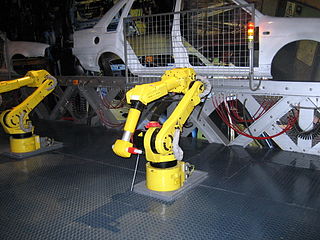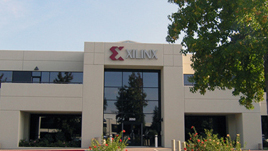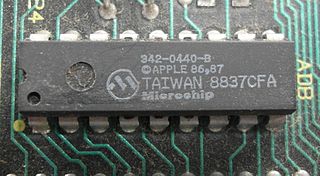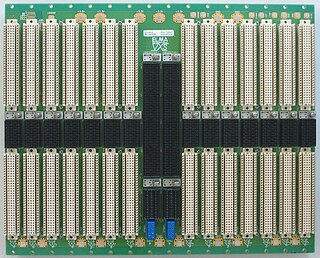
VMEbus is a computer bus standard, originally developed for the Motorola 68000 line of CPUs, but later widely used for many applications and standardized by the IEC as ANSI/IEEE 1014-1987. It is physically based on Eurocard sizes, mechanicals and connectors, but uses its own signalling system, which Eurocard does not define. It was first developed in 1981 and continues to see widespread use today.
Futurebus, or IEEE 896, is a computer bus standard, intended to replace all local bus connections in a computer, including the CPU, memory, plug-in cards and even, to some extent, LAN links between machines. The effort started in 1979 and didn't complete until 1987, and then immediately went into a redesign that lasted until 1994. By this point, implementation of a chip-set based on the standard lacked industry leadership. It has seen little real-world use, although custom implementations continue to be designed and used throughout industry.

Electronic test equipment is used to create signals and capture responses from electronic devices under test (DUTs). In this way, the proper operation of the DUT can be proven or faults in the device can be traced. Use of electronic test equipment is essential to any serious work on electronics systems.

Mechatronics, which is also called mechatronics engineering is an interdisciplinary branch of engineering that focuses on the engineering of electronic, electrical and mechanical engineering systems, and also includes a combination of robotics, electronics, computer, telecommunications, systems, control, and product engineering. As technology advances over time, various subfields of engineering have succeeded in both adapting and multiplying. The intention of mechatronics is to produce a design solution that unifies each of these various subfields. Originally, the field of mechatronics was intended to be nothing more than a combination of mechanics and electronics, hence the name being a portmanteau of mechanics and electronics; however, as the complexity of technical systems continued to evolve, the definition had been broadened to include more technical areas.

Xilinx, Inc. is an American technology company that is primarily a supplier of programmable logic devices. The company invented the field-programmable gate array (FPGA). It is the semiconductor company that created the first fabless manufacturing model.

Automatic test equipment or automated test equipment (ATE) is any apparatus that performs tests on a device, known as the device under test (DUT), equipment under test (EUT) or unit under test (UUT), using automation to quickly perform measurements and evaluate the test results. An ATE can be a simple computer-controlled digital multimeter, or a complicated system containing dozens of complex test instruments capable of automatically testing and diagnosing faults in sophisticated electronic packaged parts or on wafer testing, including system on chips and integrated circuits.

Microchip Technology Inc. is a publicly-listed American corporation that is a manufacturer of microcontroller, mixed-signal, analog and Flash-IP integrated circuits. Its products include microcontrollers, Serial EEPROM devices, Serial SRAM devices, embedded security devices, radio frequency (RF) devices, thermal, power and battery management analog devices, as well as linear, interface and wireless solutions.

Integrated Micro-electronics, Inc. provides electronics manufacturing services (EMS) and power semiconductor assembly and test services (SATS) with manufacturing facilities in Asia, Europe, and North America. Its headquarters is located in Biñan, Laguna, Philippines.

A computer appliance is a computer with software or firmware that is specifically designed to provide a specific computing resource. Such devices became known as appliances because of the similarity in role or management to a home appliance, which are generally closed and sealed, and are not serviceable by the user or owner. The hardware and software are delivered as an integrated product and may even be pre-configured before delivery to a customer, to provide a turn-key solution for a particular application. Unlike general purpose computers, appliances are generally not designed to allow the customers to change the software and the underlying operating system, or to flexibly reconfigure the hardware.
In computing, the term data warehouse appliance (DWA) was coined by Foster Hinshaw for a computer architecture for data warehouses (DW) specifically marketed for big data analysis and discovery that is simple to use and high performance for the workload. A DWA includes an integrated set of servers, storage, operating systems, and databases.

A system on a module (SOM) is a board-level circuit that integrates a system function in a single module. It may integrate digital and analog functions on a single board. A typical application is in the area of embedded systems. Unlike a single-board computer, a SOM serves a special function like a system on a chip (SoC). The device integrated in the SOM typically requires a high level of interconnection for reasons such as speed, timing, bus-width etc., in a highly integrated module. There are benefits in building a SOM, as for SoC; one notable result is to reduce the cost of the base board or the main PCB. Two other major advantages of SOMs are design-reuse and that they can be integrated into many embedded computer applications.

VPX technology was presented at Bus&Board (VITA) in 2004. VPX, also known as VITA 46, is an ANSI standard that provides VMEbus-based systems with support for switched fabrics over a new high speed connector. Defined by the VITA working group, it has been designed specifically with defense applications in mind, with an enhanced module standard that enables applications and platforms with superior performance. VPX retains VME's existing 6U and 3U Eurocard form factors, supporting existing PCI Mezzanine Card (PMC) and XMC mezzanines, and maintaining the maximum possible compatibility with VMEbus.

Datacube Inc. (1978–2005) was an image processing company that developed real-time hardware and software products for the industrial, medical, military and scientific markets.
A virtual security appliance is a computer appliance that runs inside virtual environments. It is called an appliance because it is pre-packaged with a hardened operating system and a security application and runs on a virtualized hardware. The hardware is virtualized using hypervisor technology delivered by companies such as VMware, Citrix and Microsoft. The security application may vary depending on the particular network security vendor. Some vendors such as Reflex Systems have chosen to deliver Intrusion Prevention technology as a Virtualized Appliance, or as a multifunctional server vulnerability shield delivered by Blue Lane. The type of security technology is irrelevant when it comes to the definition of a Virtual Security Appliance and is more relevant when it comes to the performance levels achieved when deploying various types of security as a virtual security appliance. Other issues include visibility into the hypervisor and the virtual network that runs inside.
Hybricon Corporation is a provider of systems packaging serving the Military, Aerospace, Homeland Security, Medical and high-end Industrial markets and develops embedded computing systems using OpenVPX, VPX, VXS, VMEbus, VME64X, CompactPCI, Rugged MicroTCA, and custom bus structures.
Himax Technologies, Inc. is a leading supplier and fabless semiconductor manufacturer headquartered in Tainan City, Taiwan founded on 12 June 2001. The company is publicly traded and listed on the Nasdaq Stock Market under the symbol HIMX. The Himax Technologies Limited functions as a holding under the Cayman Islands Companies Law.

Elma Electronic is a publicly traded Swiss electronics company founded in 1960 and based in Wetzikon, Switzerland. The company has 5 product divisions: Systems Platforms, Backplanes, Enclosures & Components, Rotary Switches, and Cabinet Enclosures. The largest segment is systems packaging serving the military, aerospace, homeland security, medical and industrial markets. The Elma Bustronic division develops backplanes, including VME320, which was the world's fastest VME backplane in 1997. Elma Bustronic also develops backplanes in OpenVPX, VMEbus, VME64X, CompactPCI, MicroTCA, and custom bus structures. Elma is an executive member of the PCI Industrial Computer Manufacturers Group (PICMG), VME International Trade Association, and member of the OpenVPX Industry Working Standards Group.

Schroff GmbH is a German manufacturer of electronic packaging products. Schroff products include cabinets, housings, chassis and related components for multiple markets such as telecommunications, data centers and traffic management. Schroff GmbH is headquartered in Straubenhardt near Pforzheim, and was founded in 1962 by Gunther Schroff. It is now part of the UK-based company nVent Electric plc. nVent employs 9,000 people worldwide of which about 1,500 are part of the Schroff Group.

Silicom is a publicly traded company, headquartered in Israel, that specializes in the design, manufacture and marketing of connectivity solutions for a range of servers and server-based systems. Its shares are listed on the NASDAQ Global Market and on the Tel Aviv Stock Exchange. Silicom is a member of the RAD Group family of companies.
Acromag, Inc. manufactures embedded computing, process instrumentation, and distributed I/O products.













